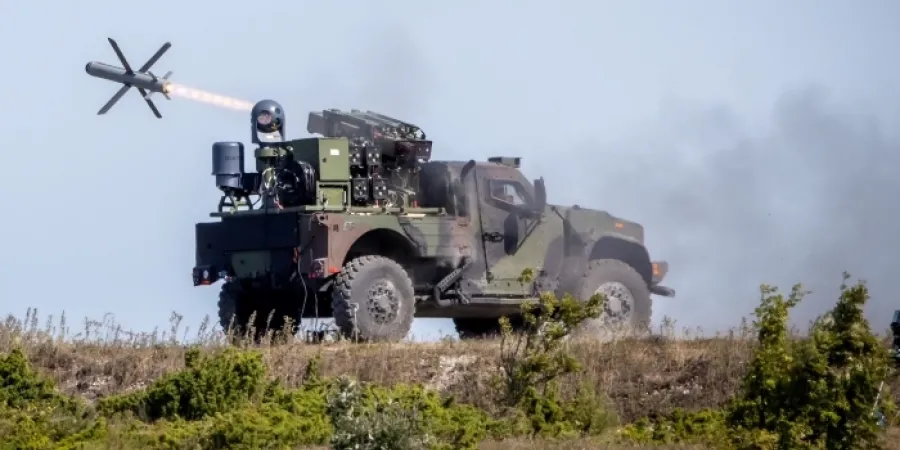Rafael, Oshkosh demonstrate firing of Spike missiles from tactical vehicle
In the demonstration hosted by the Estonian Navy, two Spike missiles were fired from a launcher on the Oshkosh JLTV. The targets located in the sea, beyond the line of sight, were destroyed, Rafael said
Eyal Boguslavsky
| 28/07/2021
Israel's Rafael Advanced Defense Systems and American company Oshkosh Defense have conducted a successful demonstration of the firing of Rafael's Spike NLOS (Non-Line-Of-Sight) missile from an Oshkosh Joint Light Tactical Vehicle (JLTV). The demonstration hosted by the Estonian Navy was attended by representatives from 14 countries, including NATO countries that have deployed the missile, as well as senior Estonian Defense Ministry officials and members of the Estonian Armed Forces, Rafael said.
The demonstration included the firing of two Spike NLOS missiles from a launcher mounted on the Oshkosh JLTV. The missiles were fired at two targets with different characteristics in the sea, beyond the line of sight, and both targets were destroyed. The demonstration displayed the missile's capability to address modern coastal protection challenges including a variety of targets, either at sea or on land, and dense marine traffic, according to Rafael.
Last year, as reported by Israel Defense, the Estonian Army conducted a demonstration in which two short-range Spike SR missiles were fired. The Estonian Ministry of Defense signed a framework agreement with joint venture Eurospike in September 2019 to acquire Rafael's Spike long-range (LR) anti-tank guided missiles for €40 million (approx. $45 million).
The Spike NLOS is a fifth generation, 32 km-range missile that is highly effective due to its navigation system and lethal warheads capable of destroying a wide range of targets. It is part of the Spike family of multi-mission, precise, electro-optical missiles that has been deployed by 37 customers worldwide, according to the company.
The Spike NLOS enables visual target identification and precision strikes at extended ranges and beyond the line of sight against targets on land or at sea. It has a bi-directional datalink, enabling full control of the missile from launch until impact with pinpoint precision that is not affected by range. Unlike laser-guided or active radar munitions, the missile's electro-optical guidance is completely passive and is capable of operating in GPS-denied environments, Rafael said.
In the demonstration hosted by the Estonian Navy, two Spike missiles were fired from a launcher on the Oshkosh JLTV. The targets located in the sea, beyond the line of sight, were destroyed, Rafael said
Israel's Rafael Advanced Defense Systems and American company Oshkosh Defense have conducted a successful demonstration of the firing of Rafael's Spike NLOS (Non-Line-Of-Sight) missile from an Oshkosh Joint Light Tactical Vehicle (JLTV). The demonstration hosted by the Estonian Navy was attended by representatives from 14 countries, including NATO countries that have deployed the missile, as well as senior Estonian Defense Ministry officials and members of the Estonian Armed Forces, Rafael said.
The demonstration included the firing of two Spike NLOS missiles from a launcher mounted on the Oshkosh JLTV. The missiles were fired at two targets with different characteristics in the sea, beyond the line of sight, and both targets were destroyed. The demonstration displayed the missile's capability to address modern coastal protection challenges including a variety of targets, either at sea or on land, and dense marine traffic, according to Rafael.
Last year, as reported by Israel Defense, the Estonian Army conducted a demonstration in which two short-range Spike SR missiles were fired. The Estonian Ministry of Defense signed a framework agreement with joint venture Eurospike in September 2019 to acquire Rafael's Spike long-range (LR) anti-tank guided missiles for €40 million (approx. $45 million).
The Spike NLOS is a fifth generation, 32 km-range missile that is highly effective due to its navigation system and lethal warheads capable of destroying a wide range of targets. It is part of the Spike family of multi-mission, precise, electro-optical missiles that has been deployed by 37 customers worldwide, according to the company.
The Spike NLOS enables visual target identification and precision strikes at extended ranges and beyond the line of sight against targets on land or at sea. It has a bi-directional datalink, enabling full control of the missile from launch until impact with pinpoint precision that is not affected by range. Unlike laser-guided or active radar munitions, the missile's electro-optical guidance is completely passive and is capable of operating in GPS-denied environments, Rafael said.



